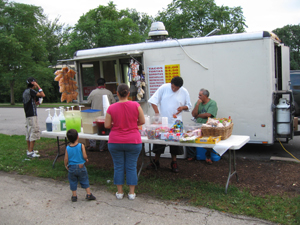
My oldest son found a frog at the forest preserves and decided to keep it. He bought an aquarium, but soon the house smelled of stagnant water. He really didn’t clean the aquarium regularly or properly. Then he got bored of having a frog. He thought of releasing the frog in our backyard, but I told him it would die there and that would be inhumane. I suggested he take the frog to the Marquette Park lagoon where it would at least stand a chance to survive. A week passed and the frog was still our roommate and the aquarium water was still polluting the air we breathed. Yesterday, we both were home at the same time, with free time at the same time–something that rarely happens with our busy schedules (even though I’m on summer vacation now!).
So, I said, “Let’s take the frog to Marquette Park now.” Amazingly, he agreed. However, he didn’t want to touch the frog because of the putrid smell. He brought the aquarium down from his bedroom and put it on the front porch. He almost threw as he set the tank down. So, I was the one who took the frog out of the smelly tank and put it into a five-gallon bucket to take to Marquette Park.
I’ve been going to Marquette Park since the 1960s. My parents always loved taking us to parks or beaches whenever possible. When my mother got her driver’s license, she ventured further away from our house. Once she took us to Brookfield Zoo! But first she had to build up her courage. So she took us to Marquette Park. She had heard that it was a nice park. She drove us there in her 1964 Chevy Impala convertible. I remember driving on Marquette Road to get to Marquette Park. My mother was amazed by the houses we saw there. When we drove back home on Marquette Road, my mother said, “Some day we will live on Marquette Road!”
Eventually, we did live at 2509 W. Marquette Road! Many Lithuanians lived in Marquette Park. There were very few Mexicans in the neighborhood back in the early 1970s. But that didn’t stop my mother from moving in. I missed my old friends at Back of the Yards, but Marquette Park was a much bigger and better park than Davis Square Park. Marquette Park had a lagoon for fishing, sailing, RC boats. There were plenty of activities at the field house where I eventually joined the Mar Par Chessmen. Years later, I joined the Marquette Park Track Club that was coached by Jack Bolton. There were soccer and baseball leagues. I went there for a wrestling match when I was in the eighth grade. I got to know Marquette Park very well. There were very few Mexicans at the park then.
So, imagine my surprise when I returned with my sons to Marquette Park to release the frog (I bet you thought I forgot all about the frog!). Over the past few years the neighborhood has been changing. African-Americans started moving in. Now, Mexicans are moving in, too. Whenever I drive through the neighborhood, I see more store signs in Spanish. Since I don’t spend all that much time there, I wasn’t sure what to expect when I arrived at the park. Marquette Park was filled with mostly Mexicans. Several soccer–actually, fútbol–games were in progress. Unlike the 1970s, all the players were Mexican. Ditto when I drove past the concrete basketball courts. I was also surprised by the Mexican food vendor in the picture above. They sold the usual Mexican food items: elotes, tacos, gorditas, raspados. My son was hungry, so he bought a couple of tacos de carne asada and an elote in a cup. I didn’t even know you could buy elote in a cup! I always buy it on a stick! As Dios intended. But, I’ve also seen pizza in a cup. So why not elote in a cup? And I’m not even going bring up walking tacos here.
Anyway, we placed the frog (See! I still remember that this post was about the frog!) on the grassy shore of the lagoon and the frog immediately jumped into the water. Live long and prosper!
